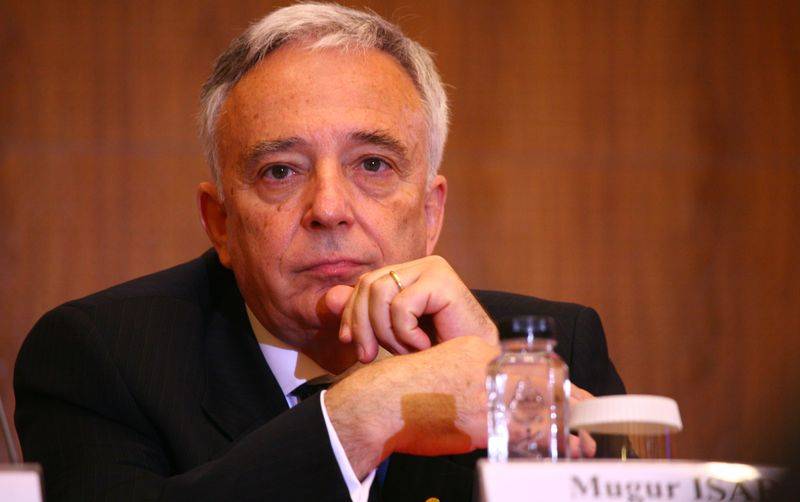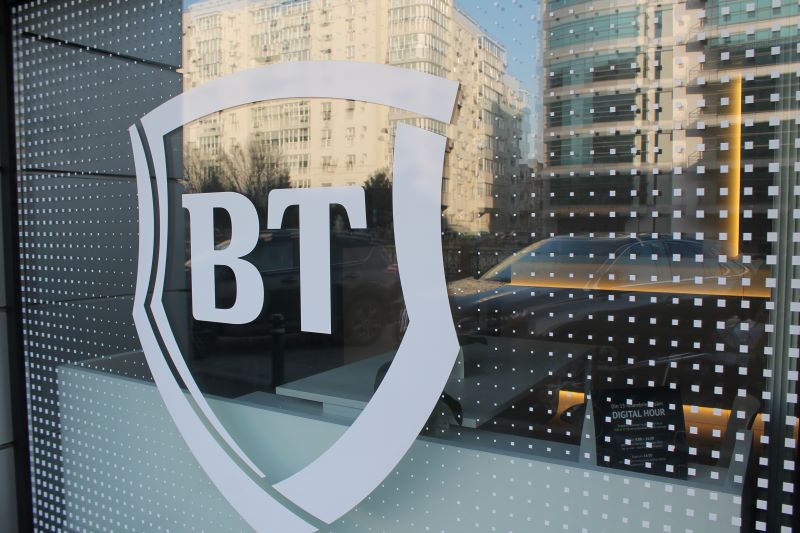Mugur Isarescu, NBR Governor: Disruptions in the transmission mechanism of the monetary policy
 Autor: Bancherul.ro
Autor: Bancherul.ro
2015-06-04 17:05
Mugur Isărescu, NBR Governor - Speech at Euromoney Conferences - The Regional Finance and Investment Conference for SouthEast Europe
Mr. Prime-Minister,
Ladies and Gentlemen,
First of all, I would like to thank Euromoney for inviting me again at its Regional Finance and Investment Conference for South-East Europe. I have to confess that I am fond of the Euromoney magazine, which dates back to the beginning of my career as an economist at the Institute for World Economy, in the early seventies. As already mentioned in the February 2015 Euromoney issue with focus on Romania, this was among the first foreign magazines I have read and one of the primary sources of information on currency issues and modern banking. As a matter of fact, I liked the magazine so much that one of the persons I was very keen on meeting during my first visit to London in 1976 was Padraic Fallon, editor-in-chief at that time.
In my speech today, I intend to briefly touch the most relevant developments in the Romanian economy, which would hopefully provide further arguments for Euromoney’s choice to organise the event in Bucharest for the second year in a row.
Of course, any such account is bound to start with the lessons from the global crisis. In my opinion, the most important is that there is no substitute for consistent economic policies. The correction of economic policy errors is always painful everywhere and, while difficult to be comprehended by the public at large, it is absolutely necessary.
Romania is a case in point. Against the background of capital account liberalisation in the run-up to EU membership, massive foreign capital inflows fuelled fast economic growth in 2004-2008 (with an annual average of 7.2 percent), thus leading to the build-up of large macroeconomic imbalances.
While the monetary policy stance was countercyclical at the time, it was very difficult to control expansion in foreign currency lending undertaken by the local subsidiaries of foreign banks with the instruments available and even with the recourse to unorthodox measures. Furthermore, fiscal and wage policies remained strongly pro-cyclical, particularly in the last two years preceding the crisis outburst. Therefore, when the crisis broke out, Romania grappled with a wide structural fiscal gap (around -8% of GDP in 2008), a double-digit current account deficit (between 2006 and 2008) and high inflation readings (7.85 percent on average in 2008).
Faced with the realities of the crisis, Romania had to make the necessary corrections to mend these imbalances in an orderly way. The three agreements with the EU, the IMF and the World Bank – initially, a financing agreement and later, precautionary ones – provided the framework for such an adjustment.
The struggle seems to have borne fruit already: crisis-inflicted output losses have been made up for, as the economic advance is not only robust, judging by the prevailing European standards, but – this time around – sustainable, as well. The current account deficit narrowed to 0.4 percent of GDP in 2014 from a peak of 13.4 percent in 2007, inflation hit historical lows (1.1 percent on average in 2014 and an annual rate of 0.65 percent in April 2015 as compared to the 8-9 percent figures in 2008), while the sharp fiscal consolidation (among the highest in the European Union) brought the deficit back into the comfort zone (1.5 percent in 2015, down from 9 percent in 2009). Moreover, Romania fully complies with the requirements of the preventive arm of the Stability and Growth Pact by reaching in 2014 the medium-term objective, defined as a structural deficit of 1 percent of GDP.
Against this background, whilst at the onset of the crisis, Romania fell short of all four Maastricht criteria, they are currently fully met, but the big challenge that lies ahead is to ensure the durability of this achievement.
While Romania seems to have wrapped up the period of macroeconomic adjustments, the future mission of economic policies is to keep in place the balances restored with so many efforts, by shifting the focus towards structural reforms meant to boost the economy’s growth potential in the long run and to underpin the viability of the economy in the monetary union by enhancing its flexibility and resilience to shocks. I have in mind keener competition and increased efficiency in key sectors of the economy, such as energy and transportation, addressing the issue of youth and long-term unemployment, also via reforms in the education system, a better absorption of EU funds, as well as an improved quality of infrastructure, roads in particular.
Moving to monetary policy, while it is true that in the case of Romania it did not have to navigate in the uncharted waters of quantitative easing and negative nominal interest rates, this does not mean that it is bereft of challenges. I would mention first the difficulty in designing monetary policy in a context where the negative output gap is closing fast, while a perfect storm of favourable supply-side shocks – namely oil and food price drops and indirect tax cuts – has been generating low inflation readings for quite a while now, with the potential to alter inflation expectations in the medium term.
Moreover, the conduct of the monetary policy with a view to ensuring price stability over the medium term in a manner supportive of economic recovery, but also synchronised with the monetary policy cycles of central banks in the region and the euro area is further conditional upon the behaviour of the other components of the policy mix (fiscal, structural, EU fund absorption).
Another challenge is the fact that there are still disruptions in the transmission mechanism of the monetary policy. Specifically, even though the interest rates on new loans in domestic currency have declined further (by around 2 percentage points over the last 12 months) in response to the policy rate cuts, the annual growth of credit to the private sector has levelled off in recent months (to around -4 percent in 2015 to date).
While this was mainly the outcome of the ongoing banking system balance sheet clean-up (in the absence of which the annual growth rate in real terms would have been positive and slightly increasing), it also reflected the impact of a number of factors that are hampering the functioning of the monetary policy transmission mechanism (in particular that of the risk-taking channel). The still high, albeit significantly declining, level of NPLs (just below 14 percent in March 2015 as compared with above 20 percent a year ago), the persistently elevated risk aversion of banks, and the deleveraging of euro area credit institutions are such factors that further depress credit supply. At the same time, the insufficient gains in confidence, particularly in the case of businesses, hinder credit demand.
On the bright side, with reference to the transmission mechanism, I should point out the steady improvement testified by the ever expanding share of local currency-denominated credit in total lending, which has recently increased to 45 percent and looks set to reach 50 percent by the end of the year.
Another challenging objective of the central bank is to normalise the operational framework of the monetary policy, which was affected in time by several constraints. Obviously, I am talking about the still high reserve requirement ratios (given the need to contain credit expansion, foreign currency lending in particular, during the economic boom) and the relatively large width of the interest rate corridor (initially warranted by the imperative of cooling off speculative capital inflows and domestic currency appreciation). The NBR has capitalised, in the past two years, on the window of opportunity provided by the favourable macroeconomic and financial background to rectify the situation to some extent, yet the process needs to be continued until nearing the prevailing levels across the EU. Looking ahead, it is essential that the NBR identify, as it has until now, the right timing for the upcoming stages of the alignment process to unfold without impairing the smooth functioning of the markets and without deteriorating key indicators for investor sentiment or, more generally, public perception.
Last but not least, I should mention that the neighbourhood we live in is a powerful source of risks: I am referring, of course, to the still unsolved issue of Greece’s debt financing and the smouldering conflict in Ukraine. Both factors have the potential to influence investor risk appetite and, as such, the volume and direction of capital flows, entailing larger fluctuations in the exchange rate of the domestic currency. Apart from the unrest in the region, the expected growing divergence between the monetary policy stances of the world’s major central banks could also have a bearing on the dynamics of capital flows and therefore on the exchange rate volatility on the domestic market.
I will not go any further with my monetary policy considerations, as I am convinced that the subject will be extensively dealt with by the speakers in the second panel of the conference. Most surely, a lot of interesting ideas will emerge during the debate and I look forward to getting a flavour of other central bankers’ perspective. As a matter of fact, this is true for all the other panels and workshops, as they encompass topics particularly relevant to the present and future of the economies in South-East Europe.
4 June 2015
Comentarii
Adauga un comentariu
Adauga un comentariu folosind contul de Facebook
Alte stiri din categoria: Opinie
Banca Transilvania implineste 30 de ani
Mesaj top management BT, 16 februarie 2024 Banca Transilvania: Sunt 30 de ani de când creștem în România și de când vedem România crescând Astăzi este ziua Băncii Transilvania. Orice aniversare ne duce cu detalii
De cand si cat de mult ar putea sa scada dobanzile in 2024?
Diminuarea inflatiei ridica intrebarea cu privire la momentul in care ar putea sa inceapa sa scada si dobanda de referinta stabilita de Banca Nationala a Romaniei (BNR) si implicit cele la credite si depozite. Discutiile privind scaderea dobanzii BNR ar putea detalii
Ce responsabilitate au bancile in cazul fraudelor online?
„Am fost victima unei fraude prin Neocapital și mi s-au furat sume importante prin transfer online neautorizat de mine”, ne-a scris un cititor. „Sint grupuri organizate, iar băncile nu au sisteme de securizare eficienta a conturilor detalii
Creditele ipotecare ar putea creste in 2024, estimeaza Banca Transilvania
Banca Transilvania se asteapa ca cererea de credite ipotecare sa creasca in 2024, datorita reducerii dobanzilor si a unei oferte de preturi mai accesibile pe piata rezidentiala, conform declaratiilor directorului bancii, Omer Tetik. ”Creșterea detalii
- Rambursarea ratelor la credite in Romania se face ca in celelalte tari din Europa; motoda propusa de ANPC este contrara interesului consumatorilor
- De ce ar majora bancile comisioanele pentru cash, daca se limiteaza cash-ul?
- Simona Halep, sustinuta in continuare de Banca Transilvania
- Romanii au incredere in banci ca le pot rezolva problemele, arata un sondaj
- Bancile sunt suspectate ca blocheaza accesul unor clienti la credite, prin scorul FICO al Biroului de Credit
- Doar 21% dintre romani au probleme cu băncile și IFN-urile, arata un sondaj CSALB
- De ce trebuie sa merg la ghiseu pentru activarea aplicatiei YOU BRD? (actualizat)
- Contractele cu bancile si IFN-urile pot fi imbunatatite cu ajutorul CSALB
- ARB acuza ANPC de abuz si prejudicii grave de imagine aduse sistemului bancar
- BCR explica diferenta dintre ratele egale si cele descrescatoare la credite
Profil de Bancher
-
Ionut Stanimir, Director comunicare
BCR

Ionut Stanimir (foto), fostul sef al ... vezi profil
Criza COVID-19
- In majoritatea unitatilor BRD se poate intra fara certificat verde
- La BCR se poate intra fara certificat verde
- Firmele, obligate sa dea zile libere parintilor care stau cu copiii in timpul pandemiei de coronavirus
- CEC Bank: accesul in banca se face fara certificat verde
- Cum se amana ratele la creditele Garanti BBVA
Topuri Banci
- Topul bancilor dupa active si cota de piata in perioada 2022-2015
- Topul bancilor cu cele mai mici dobanzi la creditele de nevoi personale
- Topul bancilor la active in 2019
- Topul celor mai mari banci din Romania dupa valoarea activelor in 2018
- Topul bancilor dupa active in 2017
Asociatia Romana a Bancilor (ARB)
- Băncile din România nu au majorat comisioanele aferente operațiunilor în numerar
- Concurs de educatie financiara pentru elevi, cu premii in bani
- Creditele acordate de banci au crescut cu 14% in 2022
- Romanii stiu educatie financiara de nota 7
- Gradul de incluziune financiara in Romania a ajuns la aproape 70%
ROBOR
- ROBOR: ce este, cum se calculeaza, ce il influenteaza, explicat de Asociatia Pietelor Financiare
- ROBOR a scazut la 1,59%, dupa ce BNR a redus dobanda la 1,25%
- Dobanzile variabile la creditele noi in lei nu scad, pentru ca IRCC ramane aproape neschimbat, la 2,4%, desi ROBOR s-a micsorat cu un punct, la 2,2%
- IRCC, indicele de dobanda pentru creditele in lei ale persoanelor fizice, a scazut la 1,75%, dar nu va avea efecte imediate pe piata creditarii
- Istoricul ROBOR la 3 luni, in perioada 01.08.1995 - 31.12.2019
Taxa bancara
- Normele metodologice pentru aplicarea taxei bancare, publicate de Ministerul Finantelor
- Noul ROBOR se va aplica automat la creditele noi si prin refinantare la cele in derulare
- Taxa bancara ar putea fi redusa de la 1,2% la 0,4% la bancile mari si 0,2% la cele mici, insa bancherii avertizeaza ca indiferent de nivelul acesteia, intermedierea financiara va scadea iar dobanzile vor creste
- Raiffeisen anunta ca activitatea bancii a incetinit substantial din cauza taxei bancare; strategia va fi reevaluata, nu vor mai fi acordate credite cu dobanzi mici
- Tariceanu anunta un acord de principiu privind taxa bancara: ROBOR-ul ar putea fi inlocuit cu marja de dobanda a bancilor
Statistici BNR
- Deficitul contului curent după primele două luni, mai mare cu 25%
- Deficitul contului curent, -0,39% din PIB după prima lună a anului
- Deficitul contului curent, redus cu 17%
- Inflatia a încheiat anul 2023 la 6,61%, semnificativ sub prognoza oficială
- Deficitul contului curent, redus cu o cincime după primele zece luni ale anului
Legislatie
- Legea nr. 311/2015 privind schemele de garantare a depozitelor şi Fondul de garantare a depozitelor bancare
- Rambursarea anticipata a unui credit, conform OUG 50/2010
- OUG nr.21 din 1992 privind protectia consumatorului, actualizata
- Legea nr. 190 din 1999 privind creditul ipotecar pentru investiții imobiliare
- Reguli privind stabilirea ratelor de referinţă ROBID şi ROBOR
Lege plafonare dobanzi credite
- BNR propune Parlamentului plafonarea dobanzilor la creditele bancilor intre 1,5 si 4 ori peste DAE medie, in functie de tipul creditului; in cazul IFN-urilor, plafonarea dobanzilor nu se justifica
- Legile privind plafonarea dobanzilor la credite si a datoriilor preluate de firmele de recuperare se discuta in Parlament (actualizat)
- Legea privind plafonarea dobanzilor la credite nu a fost inclusa pe ordinea de zi a comisiilor din Camera Deputatilor
- Senatorul Zamfir, despre plafonarea dobanzilor la credite: numai bou-i consecvent!
- Parlamentul dezbate marti legile de plafonare a dobanzilor la credite si a datoriilor cesionate de banci firmelor de recuperare (actualizat)
Anunturi banci
- Bancile comunica automat cu ANAF situatia popririlor
- BRD bate recordul la credite de consum, in ciuda dobanzilor mari, si obtine un profit ridicat
- CEC Bank a preluat Fondul de Garantare a Creditului Rural
- BCR aproba credite online prin aplicatia George, dar contractele se semneaza la banca
- Aplicatia Eximbank, indisponibila temporar
Analize economice
- Rezultatul economic pe 2023, tot +2,1% dar cu 7 miliarde lei mai mare
- România - prima în UE la inflație, prin efect de bază
- Deficitul comercial lunar a revenit peste cota de 2 miliarde euro
- România, 78% din media UE la PIB/locuitor în 2023
- România - prima în UE la inflație, prin efect de bază
Ministerul Finantelor
- Deficitul bugetar, -2,06% din PIB pe primul trimestru al anului
- Datoria publică, imediat sub pragul de 50% din PIB la începutul anului 2024
- Deficitul bugetar, deja -1,67% din PIB după primele două luni
- Datoria publică, sub pragul de 50% din PIB la finele anului 2023
- Deficitul bugetar, din ce în ce mai mare la început de an
Biroul de Credit
- FUNDAMENTAREA LEGALITATII PRELUCRARII DATELOR PERSONALE IN SISTEMUL BIROULUI DE CREDIT
- BCR: prelucrarea datelor personale la Biroul de Credit
- Care banci si IFN-uri raporteaza clientii la Biroul de Credit
- Ce trebuie sa stim despre Biroul de Credit
- Care este procedura BCR de raportare a clientilor la Biroul de Credit
Procese
- Un client Credius obtine in justitie anularea creditului, din cauza dobanzii prea mari
- Hotararea judecatoriei prin care Aedificium, fosta Raiffeisen Banca pentru Locuinte, si statul sunt obligati sa achite unui client prima de stat
- Decizia Curtii de Apel Bucuresti in procesul dintre Raiffeisen Banca pentru Locuinte si Curtea de Conturi
- Vodafone, obligata de judecatori sa despagubeasca un abonat caruia a refuzat sa-i repare un telefon stricat sau sa-i dea banii inapoi (decizia instantei)
- Taxa de reziliere a abonamentului Vodafone inainte de termen este ilegala (decizia definitiva a judecatorilor)
Stiri economice
- România, total în afara țărilor similare cu deficitul de cont curent
- Producția industrială pe februarie, cu aproape 7% sub cea din urmă cu cinci ani
- Inflația anuală a revenit la nivelul de la finele anului anterior
- Pensia reală de asigurări sociale de stat a crescut anul trecut cu 2,9%
- Producția de cereale boabe pe 2023, cu o zecime mai mare față de anul precedent
Statistici
- Care este valoarea salariului minim brut si net pe economie in 2024?
- Cat va fi salariul brut si net in Romania in 2024, 2025, 2026 si 2027, conform prognozei oficiale
- România, pe ultimul loc în UE la evoluția productivității muncii în agricultură
- INS: Veniturile romanilor au crescut anul trecut cu 10%. Banii de mancare, redistribuiti cu precadere spre locuinta, transport si haine
- Inflatia anuala - 13,76% in aprilie 2022 si va ramane cu doua cifre pana la mijlocul anului viitor
FNGCIMM
- Programul IMM Invest continua si in 2021
- Garantiile de stat pentru credite acordate de FNGCIMM au crescut cu 185% in 2020
- Programul IMM invest se prelungeste pana in 30 iunie 2021
- Firmele pot obtine credite bancare garantate si subventionate de stat, pe baza facturilor (factoring), prin programul IMM Factor
- Programul IMM Leasing va fi operational in perioada urmatoare, anunta FNGCIMM
Calculator de credite
- ROBOR la 3 luni a scazut cu aproape un punct, dupa masurile luate de BNR; cu cat se reduce rata la credite?
- In ce mall din sectorul 4 pot face o simulare pentru o refinantare?
Noutati BCE
- Acord intre BCE si BNR pentru supravegherea bancilor
- Banca Centrala Europeana (BCE) explica de ce a majorat dobanda la 2%
- BCE creste dobanda la 2%, dupa ce inflatia a ajuns la 10%
- Dobânda pe termen lung a continuat să scadă in septembrie 2022. Ecartul față de Polonia și Cehia, redus semnificativ
- Rata dobanzii pe termen lung pentru Romania, in crestere la 2,96%
Noutati EBA
- Bancile romanesti detin cele mai multe titluri de stat din Europa
- Guidelines on legislative and non-legislative moratoria on loan repayments applied in the light of the COVID-19 crisis
- The EBA reactivates its Guidelines on legislative and non-legislative moratoria
- EBA publishes 2018 EU-wide stress test results
- EBA launches 2018 EU-wide transparency exercise
Noutati FGDB
- Banii din banci sunt garantati, anunta FGDB
- Depozitele bancare garantate de FGDB au crescut cu 13 miliarde lei
- Depozitele bancare garantate de FGDB reprezinta doua treimi din totalul depozitelor din bancile romanesti
- Peste 80% din depozitele bancare sunt garantate
- Depozitele bancare nu intra in campania electorala
CSALB
- La CSALB poti castiga un litigiu cu banca pe care l-ai pierde in instanta
- Negocierile dintre banci si clienti la CSALB, in crestere cu 30%
- Sondaj: dobanda fixa la credite, considerata mai buna decat cea variabila, desi este mai mare
- CSALB: Romanii cu credite caută soluții pentru reducerea ratelor. Cum raspund bancile
- O firma care a facut un schimb valutar gresit s-a inteles cu banca, prin intermediul CSALB
First Bank
- Ce trebuie sa faca cei care au asigurare la credit emisa de Euroins
- First Bank este reprezentanta Eurobank in Romania: ce se intampla cu creditele Bancpost?
- Clientii First Bank pot face plati prin Google Pay
- First Bank anunta rezultatele financiare din prima jumatate a anului 2021
- First Bank are o noua aplicatie de mobile banking
Noutati FMI
- FMI: criza COVID-19 se transforma in criza economica si financiara in 2020, suntem pregatiti cu 1 trilion (o mie de miliarde) de dolari, pentru a ajuta tarile in dificultate; prioritatea sunt ajutoarele financiare pentru familiile si firmele vulnerabile
- FMI cere BNR sa intareasca politica monetara iar Guvernului sa modifice legea pensiilor
- FMI: majorarea salariilor din sectorul public si legea pensiilor ar trebui reevaluate
- IMF statement of the 2018 Article IV Mission to Romania
- Jaewoo Lee, new IMF mission chief for Romania and Bulgaria
Noutati BERD
- Creditele neperformante (npl) - statistici BERD
- BERD este ingrijorata de investigatia autoritatilor din Republica Moldova la Victoria Bank, subsidiara Bancii Transilvania
- BERD dezvaluie cat a platit pe actiunile Piraeus Bank
- ING Bank si BERD finanteaza parcul logistic CTPark Bucharest
- EBRD hails Moldova banking breakthrough
Noutati Federal Reserve
- Federal Reserve anunta noi masuri extinse pentru combaterea crizei COVID-19, care produce pagube "imense" in Statele Unite si in lume
- Federal Reserve urca dobanda la 2,25%
- Federal Reserve decided to maintain the target range for the federal funds rate at 1-1/2 to 1-3/4 percent
- Federal Reserve majoreaza dobanda de referinta pentru dolar la 1,5% - 1,75%
- Federal Reserve issues FOMC statement
Noutati BEI
- BEI a redus cu 31% sprijinul acordat Romaniei in 2018
- Romania implements SME Initiative: EUR 580 m for Romanian businesses
- European Investment Bank (EIB) is lending EUR 20 million to Agricover Credit IFN
Mobile banking
- Comisioanele BRD pentru MyBRD Mobile, MyBRD Net, My BRD SMS
- Termeni si conditii contractuale ale serviciului You BRD
- Recomandari de securitate ale BRD pentru utilizatorii de internet/mobile banking
- CEC Bank - Ghid utilizare token sub forma de card bancar
- Cinci banci permit platile cu telefonul mobil prin Google Pay
Noutati Comisia Europeana
- Avertismentul Comitetului European pentru risc sistemic (CERS) privind vulnerabilitățile din sistemul financiar al Uniunii
- Cele mai mici preturi din Europa sunt in Romania
- State aid: Commission refers Romania to Court for failure to recover illegal aid worth up to €92 million
- Comisia Europeana publica raportul privind progresele inregistrate de Romania in cadrul mecanismului de cooperare si de verificare (MCV)
- Infringements: Commission refers Greece, Ireland and Romania to the Court of Justice for not implementing anti-money laundering rules
Noutati BVB
- BET AeRO, primul indice pentru piata AeRO, la BVB
- Laptaria cu Caimac s-a listat pe piata AeRO a BVB
- Banca Transilvania plateste un dividend brut pe actiune de 0,17 lei din profitul pe 2018
- Obligatiunile Bancii Transilvania se tranzactioneaza la Bursa de Valori Bucuresti
- Obligatiunile Good Pople SA (FRU21) au debutat pe piata AeRO
Institutul National de Statistica
- Comerțul cu amănuntul, în expansiune la început de an
- România, pe locul 2 în UE la creșterea comerțului cu amănuntul în ianuarie 2024
- Comerțul cu amănuntul, în creștere cu 1,9% pe anul 2023
- Comerțul cu amănuntul, în creștere pe final de an
- Comerțul cu amănuntul, stabilizat la +2% față de anul anterior
Informatii utile asigurari
- Data de la care FGA face plati pentru asigurarile RCA Euroins: 17 mai 2023
- Asigurarea împotriva dezastrelor, valabilă și in caz de faliment
- Asiguratii nu au nevoie de documente de confirmare a cutremurului
- Cum functioneaza o asigurare de viata Metropolitan pentru un credit la Banca Transilvania?
- Care sunt documente necesare pentru dosarul de dauna la Cardif?
ING Bank
- La ING se vor putea face plati instant din decembrie 2022
- Cum evitam tentativele de frauda online?
- Clientii ING Bank trebuie sa-si actualizeze aplicatia Home Bank pana in 20 martie
- Obligatiunile Rockcastle, cel mai mare proprietar de centre comerciale din Europa Centrala si de Est, intermediata de ING Bank
- ING Bank transforma departamentul de responsabilitate sociala intr-unul de sustenabilitate
Ultimele Comentarii
-
Înșelăciune
O să depun plângere când ajung în România sunt mare escroci nu știiu cum am putut crede așa ... detalii
-
Înșelăciune
La fel am pățit și eu și ce credeți după ce am plătit tot felul de taxe amenință ca are ... detalii
-
Refuz de plată la o benzinărie suma de 103 euro
Mi s-au retras de două ori suma de 48 euro și suma de 103 euro suma corectă este de 48 de euro ... detalii
-
nevoia de banci
De ce credeti ca acum nu mai avem nevoie de banci si firme de asigurari? Pentru ca acum avem ... detalii
-
Mda
ACUM nu e nevoie de asa ceva .. acum vreo 20 de ani era nevoie ... ACUM de fapt nu mai e asa multa ... detalii









